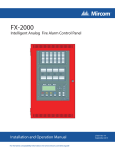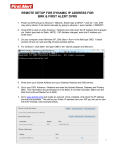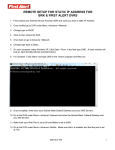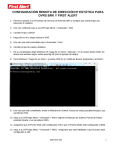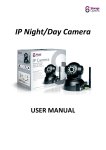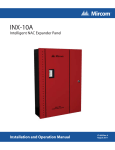Download Q-See - Digital Peripheral Solutions Security Camera QS SERIES User's Manual
Transcript
Remote Monitoring Setup Guide QS SERIES DVR MODELS PC with Windows Operating System iPhone Android BlackBerry* * Select Models Setup Guide for Remote Internet and Smartphone Monitoring, MyQ-See DDNS, and Email Notification 1 About this Manual Thank You for Choosing a Q-See Product! All of our products are backed by a conditional service warranty covering all hardware for 12 months from the date of purchase. Additionally, our products also come with a free exchange policy that covers all manufacturing defects for one month from the date of purchase. Permanent upgrading service is provided for the software and is available at www.Q-See.com. Be certain to make the most of your warranty by completing the registration form online. In addition to warranty and technical support benefits, you’ll receive notifications of product updates along with free downloadable firmware updates for your DVR. Register today at www.Q-See.com! This remote monitoring guide contains information extracted from the user’s guide and presents it in this smaller document for your convenience. and was accurate at the time it was completed. However, because of our ongoing effort to constantly improve our products, additional features and functions may have been added since that time and on-screen displays may change. We encourage you to visit our website at www.Q-see.com to check for the latest firmware updates and product announcements. Throughout the manual we have highlighted warnings and other important information that will assist you in operating your new system in a safe and trouble-free manner. Please take the time to read and follow all instructions and pay attention to alerts as shown below: IMPORTANT! Red boxes with this icon indicate warnings. To prevent possible injury or damage to the product, read all warnings before use. Please see the back of this manual for exclusions. NOTE! Text in blue boxes with the Information icon offer additional guidance and explanations about how to make the most out of your system. © 2011 Q-See. Reproduction in whole or in part without written permission is prohibited. All rights reserved. This manual and software and hardware described herein, in whole or in part, may not be reproduced, translated, or reduced to any machine-readable form without prior written approval. Trademarks: All brand names and products are trademarks or registered trademarks of their respective owners. Q-See is a registered trademark of DPS, Inc. Disclaimer: The information in this document is subject to change without notice. The manufacturer makes no representations or warranties, either express or implied, of any kind with respect to completeness of its contents. Manufacturer shall not be liable for any damages whatsoever from misuse of this product. 2 3 4. MOBILE SURVEILLANCE TABLE OF CONTENTS 1. REMOTE ACCESS 1.1 Connecting your DVR to a Network Before you get started Obtaining an IP address Static IP 6 6 6 7 9 1.2 Opening Ports UPnP DMZ Confirming that ports are opened 10 10 11 12 1.3 Connecting via a modem PPPOE 12 12 1.4 Activating DNS (Domain Name Server) 13 1.5 Setting up Dynamic Domain Name Service (DDNS) 14 1.6 Resolving Connection Issues Determine the number of routers on the network Setting up DMZ in router 2 15 15 17 2. REMOTE MONITORING 33 4.2 Mobile surveillance software Android BlackBerry iPhone and iPad Symbian Operating System Windows Mobile 34 34 37 39 41 44 Q-SEE PRODUCT WARRANTY Questions or Comments? Contact Us 47 48 18 2.1 Accessing your DVR remotely Accessing the DVR using Internet Explorer 18 18 2.2 Remote monitoring Logging in remotely The live view window Recording PTZ control Screen captures Playback Search Remote backup Remote setup 23 23 24 25 26 26 27 28 29 30 3. E-MAIL NOTIFICATION 33 4.1 Enabling mobile surveillance 32 Rev. 1.6 10/31/11 4 5 REMOTE ACCESS CHAPTER 1 In order to access your DVR remotely, you must connect it to a router or a modem. Using a router allows you to connect to your DVR from other computers on your LAN (Local Area Network) in addition to over the Web. Directly connecting to a modem makes your DVR available for connection through the Internet only. If you are using a router and wish to access your DVR from outside your LAN either over the Internet, or from your mobile device, then that router must be connected to the Internet. The instructions below will guide you through the process of configuring your DVR for remote access. Once completed, you will be able to access and control your system using one of two addresses. You will have a local IP address usable by computers connected to the same router as your DVR. This address can also be used by wireless devices as long as they are able to also connect to your router’s WiFi signal. Once you leave the area covered by your local network, you will need to use a second address to access the DVR. This is the address which will allow you to connect to your system from anywhere in the world with Internet access. And, by using Q-See’s free DDNS service, MyQ-See.com (more on this later), you’ll be able to do so using a conventional web address. OBTAINING AN IP ADDRESS Each device on a network - both a LAN or the Internet - has a specific IP address. This address is what allows different devices on the network to communicate with each other. Your QS-series DVR displays its IP address in the Network Setup window. STEP 1. Using the mouse, right-click on the screen and then select Main Menu in the pop-up shortcut menu. STEP 2. Select ADVANCE in the Main Menu window. If you are using a router, proceed with Section 1.1. If you are connecting directly to the Internet via a modem then begin with Section 1.3. MAIN MENU KEY LOCK CHN SWITCH DIGITAL ZOOM VIDEO SEARCH PICTURE 1-1 PTZ MUTE MANUAL REC STOP REC ROTATION ADVANCE 1.1 CONNECTING YOUR DVR TO A NETWORK First and foremost, you will need to physically connect your DVR to a router. This router can be part of an existing network of computers, or it can be the router/modem supplied by your Internet Service Provider (ISP) to connect you to the Internet. This connection will be made by plugging the included Ethernet cable into the port on the back of the DVR marked RJ45. Your DVR is not designed to be connected wirelessly to a network. It is also recommended that the router that the DVR is connected to should be connected directly to the Internet rather than to another router if Internet access is desired as multiple routers can create problems with connectivity. You will also need to have a computer connected to the same router - at least temporarily - to make certain settings. If, after following the instructions you are still not able to access your DVR, please see Section 1.6 Resolving Connection Issues later in this chapter. SEARCH RECORD HDD BASIC ADVANCE EXIT PICTURE 1-2 STEP 3. Click on NETWORK in the Advanced Settings Menu. BEFORE YOU GET STARTED You will need to have: • Your router’s brand, model number and manual. The manual is also usually available on your router’s manufacturer’s website. PICTURE 1-3 • The “Manuals and Software” CD that came with your DVR. It contains necessary software and links to other important programs which are mentioned in this guide. • Your router’s password (the default password should be in your router’s manual). 6 7 STEP 4. Make sure that DHCP is selected in the drop down menu at the top (item “a”). If it is not, select it, click Apply and then Exit before restarting the DVR and returning to this window. Write down the DVR’s IP address (Item “b”). At this time, you should consult your Router’s manual to determine it’s IP address, also known as the Internet- or Network Gateway address. STATIC IP a NETWORK SETUP TYPE DHCP MEDIA PORT 09000 WEB PORT 00080 IP ADDR 196.281.941.066 AUTO 075.004.019.001 DNS 199.210.011.701 DDNS SETTINGS UPNP DEFAULT The first number you wrote down, the DVR’s IP address, is what you can use to access your DVR while you are on the same network. This address can be entered into a Windows Explorer browser as you would a regular web address. See Chapter 2 Remote Monitoring for full instructions on using this feature. b OPEN However, in the event of a power outage or other event that causes the router to restart, the router will often reassign a new IP address to connected devices and you will have to repeat the procedure above to be able to log into your DVR. CLOSE APPLY EXIT PICTURE 1-4 In some situations where only your router is disconnected or powered off whlle your DVR is unaffected, you may have to restart your DVR to refresh the information on the Network Setup page to get the new IP address. To avoid this issue, return to the Network Setup window and change the pull-down Type menu to Static. Click on Apply to save your changes before exiting the menu. For your convenience, the table below lists some common router manufacturers along with their most frequently used default gateway adresses. Router Manufacturer Default IP Addresses 3Com 192.168.1.1 Apple 10.0.1.1 Asus 192.168.1.1, 192.168.1.220 Belkin 192.168.2.1, 10.1.1.1 Buffalo 192.168.11.1 Dell 192.168.1.1 D-Link 192.168.0.1, 0.30, 0.50, 1.1, 10.1.1.1 Linksys 192.168.0.1, 1.1 Microsoft 192.168.2.1 Motorola 192.168.10.1, 20.1, 30.1, 62.1, 100.1, 102.1, 1.254 MSI 192.168.1.254 Netgear 192.168.0.1, 0.227 Senao 192.168.0.1 SpeedTouch 10.0.0.138, 192.168.1.254 Trendnet 192.168.0.1, 1.1, 2.1, 10.1, U.S. Robotics 192.168.1.1, 2.1, 123.254 Zyxel 192.168.1.1, 2.1, 4.1, 10.1, 1.254, 10.0.0.2, 0.138 8 IMPORTANT! As of this writing, 2Wire brand routers do not support Static IP. Because of this, in the event that your router has to restart, you will need to repeat the steps to obtain the new IP address. Connecting the router to an uninterruptible power supply (UPS) can prevent this issue. 9 1.2 OPENING PORTS DMZ If you wish to access your DVR outside of your local network, you will need to configure your router to allow data to pass through its firewall using specified ports. This is referred to as Port Forwarding and does not constitute a security risk for your network as it only allows for specific communication to and from your DVR. For QS-series DVRs, the three ports that will be forwarded are; 80, 100 and 9000. DMZ stands for Demilitiarized Zone and is a way to instruct your router to allow data to pass to and from the ports you specify. Most current models of routers feature DMZ. Below are two methods available which will forward ports for the vast majority of users; UPnP and DMZ. Please be advised that you will only need to use one process or the other to connect and implementing both will actually cause connection difficulties. UPNP UPnP or Universal Plug ‘n’ Play is an industry-standard set of networking protocols which allows networked devices to instantly locate each other and communicate. Most routers produced since 2009 feature UPnP. At this time you should consult your router’s manual to ensure that it features UPnP. As of this writing, 2Wire brand routers DO NOT have UPnP capability and users of these routers as well as other routers without UPnP functionality will need to use the DMZ method described immediately below this section to forward their ports. By default, your DVR comes pre-configured with UPnP turned on. This setting is accessible in the Network Setup window. If UPnP is not selected as Open, you will need to select that option and then click Apply. Proceed to the end of this section for instructions on how to confirm that your ports are open using an online tool. DHCP MEDIA PORT 09000 WEB PORT 00080 IP ADDR 196.281.941.066 AUTO 075.004.019.001 DNS 199.210.011.701 DDNS SETTINGS UPNP DEFAULT OPEN CLOSE APPLY EXIT PICTURE 1-5 IMPORTANT! If you connect your system to your network using UPnP you should NOT forward your ports as described in DMZ, as it will create connectivity problems. You may skip to Confirming that Ports are Opened. 10 The exact location of DMZ within the router’s settings vary by manufacturer so please consult your router’s manual for the location of this feature. The method for accessing your router’s settings, however, is pretty standard. STEP 1. Open a web browser and enter your router’s IP address into the address bar. This address is listed in your Router’s manual. This should open your router’s control panel. Pictures 1-6 and 1-7 show two examples of the location of the DMZ controls. STEP 2. Once you have located the DMZ controls, ensure that they are enabled or turned on. NETWORK SETUP TYPE Accessing your router’s DMZ controls: PICTURE 1-6 STEP 3. Enter the DVR’s IP address in the area provided. This is the first string of numbers you wrote down in Section 1.1 Obtain an IP Address. STEP 4. Click on Apply or Save as appropriate to preserve your settings. PICTURE 1-7 11 CONFIRMING THAT PORTS ARE OPENED 1.4 ACTIVATING DNS (DOMAIN NAME SERVER) Whether you used UPnP or DMZ to open your ports, you should confirm that they have been opened without being blocked by going to www.canyouseeme.org using a computer connected to the same router as the DVR. Once you have completed the previous sections, you are able to operate your DVR remotely. However, in order to activate features such as the ability to send e-mail alerts from your system as well as being able to access it using a conventional web address, you will need to obtain the DNS (Domain Name Server) number. You will be obtaining this number from your router and entering it into the appropriate field within your DVR’s Network Setup window. STEP 1. Enter “80” into the box labeled “What Port?” Browser - Windows Internet Explorer http://canyouseeme.org/ STEP 2. Click on the Check button STEP 3. You should see a green “Success” message. If you get a red error message, you will need to return to the DVR’s Network Settings page and change the Web Port to 81, 83 or 85 and click Apply to save your changes. The DVR will need to reboot to use the new settings. You can then reattempt the check by entering that new number in the Port field. Open Port Check Tool CanYouSeeMe.org - Open Port Check Tool This page will serve as a free utility for remotely verifying a port is open or closed. It will be useful for users who wish to check to see if a server or ISP is blocking certain ports. Your IP: 81.919.622.24 What Port? Check Success: I can see your service on 81.919.622.24 on port (80) Your ISP is not blocking port 80 PICTURE 1-8 STEP 4. Repeat for ports 100 and 9000. If ports 100 and 9000 are blocked, then use a number in that range (ie; 110, 9100, etc.) This website will also display your Public IP address near the top of the page above the box where you entered your port number. This is the number which you will use to access the DVR Fine using a web browser or your mobile device from outside of your local network (away from the building in which your DVR is located). Please note that if you had to use a different port number than 80 for the web port, you will have to add a colon (:) and that port number to the end of the address shown. Example 82.919.622.24:81. 1.3 CONNECTING VIA A MODEM STEP 1. Open a web browser and enter Page Safety Tools your router’s IP gateway address into the address bar. This address is the second set of numbers you wrote down in Section 1.1 Obtain an IP Address and it ends with 001. This should open your router’s control panel. Contact your ISP for the User Name and Password needed for the router. Select PPOE from the Type pull-down menu and hit OK. Enter the User Name and Password into the appropriate fields. http://81.919.622.24 Router SETTINGS DEVICE INFO STATUS ADVANCED DEVICE INFORMATION LOGS All of your Internet and network connection details are displayed on t STATISTICS INTERNET SESSIONS WAN MAC Address : IP Address : Subnet Mask : Default Gateway : Primary DNS Server : Secondary DNS Server : Advanced DNS : ROUTING WIRELESS STEP 2. Locate your router’s Status window (it may also be named “Information” or “Info”), it will list the DNS number – copy this down. 00:24:01:77:f9:00 81.919.622.249 255.255.255.0 81.919.622.24 10.6.196.6 (null) Disabled PICTURE 1-10 Each brand of router is different. Picture 1-10 shows an example of the location of the DNS number in a router’s status window. STEP 3. Return to the Network Setup window in your DVR and enter the DNS number into the field marked Protected Mode: On 100% DNS using the Virtual Keyboard. In cases where the DNS number on your router only shows one or two digits in a section you should enter zeroes BEFORE the number(s) to complete the three-digit section. PPPOE If you are going to attach the DVR directly to a DSL or Cable modem instead of a router you will want to select the PPPOE option in the NETWORK options. This method is instead of UPnP or DMZ and only applies if you are not using a router. Browser - Windows Internet Explorer NETWORK SETUP TYPE DHCP MEDIA PORT 09000 WEB PORT 00080 IP ADDR 196.281.941.066 AUTO 075.004.019.001 Fine DNS 010.006.196.006 DDNS SETTINGS UPNP DEFAULT OPEN CLOSE APPLY EXIT PICTURE 1-11 STEP 4. Click Apply to save your changes before exiting the window. You will need to restart your DVR for the changes to take effect. If you are continuing on with the next section, Setting up DDNS, you can wait until making those settings before restarting. PICTURE 1-9 12 13 1.5 SETTING UP DYNAMIC DOMAIN NAME SERVICE 1.6 RESOLVING CONNECTION ISSUES This is an optional step which allows you to take advantage of Dynamic Domain Name Service, or DDNS. Not to be confused with DNS in the previous section, DDNS allows you to enter a conventional web address when remotely logging into your DVR from outside of your network. It also allows you to avoid having to repeat steps in Obtain an IP Address when/ if your ISP reassigns IP addresses. Q-See offers DDNS service for free at www.MyQ-See.com and your DVR is configured accept account information from that site. There are several hardware-related situations which can prevent the DVR’s port from being properly forwarded. The presence of multiple routers or the routers not featuring UPnP or DMZ are the two most common issues. STEP 1. Open a browser window and go to www.MyQ-See.com NEW USER REGISTRATION EMAIL ADDRESS DETERMINE THE NUMBER OF ROUTERS ON THE NETWORK If there is more than one router between the DVR and the Internet it will block communication to and from your system. To find out the number of routers on your network, you will need to download a FREE router detection program. PASSWORD STEP 2. Register with the website and follow the instructions for creating a domain name. The website will display your pubic IP address and your domain name which will look like this: http://example.MyQ-See.com PASSWORD CONFIRM FIRST NAME STEP 1. Go to http://www.pcwintech. com/shanes-toolbox LAST NAME SECURITY QUESTION.. My first phone number STEP 2. Click on Detect Multiple Routers to begin the download. ANSWER CONFRIM YOU’RE HUMAN New Captcha Enter the text you see above Submit Reset PICTURE 1-12 STEP 3. Return to the Network Setup Window in your DVR and click on the DDNS Settings button to open the DDNS Setup window. NETWORK SETUP TYPE STEP 3. Unzip the application to install it. DHCP MEDIA PORT 09000 WEB PORT 00080 IP ADDR 196.281.941.066 AUTO 075.004.019.001 DNS 010.006.196.006 DDNS SETTINGS UPNP OPEN DEFAULT CLOSE APPLY EXIT PICTURE 1-13 STEP 4. In the DDNS Setup window, turn DDNS on to reveal the other required fields. Select MyQ-See.com as the service and enter the domain name along with the user name and password you used to create your account. STEP 5. Click on Apply and then exit the window to return to Network Setup. Click Apply again and then exit. You will need to restart your machine for the settings to take effect. 14 PICTURE 1-13 STEP 4. Click on the detect_routers application to run it. DDNS SETUP DDNS ON SERVICE MYQ-SEE.COM PICTURE 1-14 HOST NAME USER NAME PASSWORD DEFAULT APPLY EXIT PICTURE 1-14 15 STEP 5. Click on CHECK NOW to detect how many Routers are in the network. SETTING UP DMZ IN ROUTER 2 STEP 1. Login into Router 1 by putting the IP of Router 1 into the Internet Explorer browser, as in the example shown in Picture 1-17 where the IP address of Router 1 is 192.168.0.1 STEP 2. Find the status page on the router settings that shows the WAN/ Internet IP address and write it down this WAN IP address. STEP 3. Log into the Router 2 by putting the IP of Router 2 into the Internet Explorer browser, as in example shown in Picture 1-17 where the IP address of Router 2 is 192.168.1.1 STEP 4. Find the DMZ page in the router settings. PICTURE 1-15 STEP 6. If there is only one router detected, and you are using UPnP, then you will need to turn off that setting and attempt to connect using DMZ as described in Section 1.2 Opening Ports. If you are using DMZ, check to make sure that the UPnP option is turned off. STEP 5. Enter the WAN IP for Router 1 into the DMZ page and enable DMZ. PICTURE 1-17 NOTE! If you do not have a DMZ setting in the router, check to see if there is a Bridge setting. If so, then use the Bridge setting instead of DMZ. STEP 6. Save your changes. You have forwarded the ports on the router to which the DVR is connected, to the IP address of the DVR, and set the primary router to pass the connection to this router. If Multiple Routers are Detected If there are multiple routers, you will see a display similar to Picture 1-16. If so, it may be preferable to connect your DVR and computer to the router that connects directly to the Internet. However, this is not always possible depending upon your particular situation. PICTURE 1-16 In this case, you will need to proceed with the next section and set up DMZ in the second router to allow communications to pass through it from the first. If only one router is detected you will need to consult your router’s manual. 16 17 REMOTE MONITORING CHAPTER 2 STEP 4. Select the desired user account. 2.1 ACCESSING YOUR DVR REMOTELY Once you have configured the network settings on the DVR to match those on your router and forwarded the ports needed by the DVR to enable remote access over the Internet, you will be ready to remotely view your cameras using a webcam program based on an ActiveX control. For this to work, you will have to enable the ActiveX control options that are built into Internet Explorer. It is strongly suggested that you be running the latest version of Internet Explorer (currently IE9). As of this writing, the QS434 is being updated to work with IE9. In the interim, continue to use IE 8. The instructions below will describe the process using both version 8 and 9 of Internet Explorer. STEP 5. Select Turn User Account Control on or off PICTURE 2-4 ACCESSING THE DVR USING INTERNET EXPLORER User Account Control for Windows Vista and Windows 7 Some users of computers using Windows Vista or Windows 7 operating systems may receive an error message informing of a codec that is missing or not installed. This conflict can be resolved by turning off User Account Control (UAC). STEP 6. Uncheck the box next to “Use User Account Control (UAC) to help protect your computer.” PICTURE 2-5 STEP 7. You will then be asked to restart your computer for the change to take effect. Windows Vista STEP 1. Open the Control Panel (accessible by clicking on the Windows icon in the lower left of your screen. PICTURE 2-1 STEP 2. Select User Accounts and Family Safety. PICTURE 2-6 Windows 7 PICTURE 2-2 STEP 1. Open up the Start Menu (accessible by clicking on the Windows icon in the lower left of your screen. Microsoft Office Outlook 2007 Devices and Printers Sticky Notes Default Programs iTunes Help and Support Adobe Acrobat STEP 3. Select “Add or Remove User Account.” All Programs PICTURE 2-3 STEP 2. Type “uac” into the search bar and hit ENTER. The User Account Control will open or you will be offered a link to click to open it. uac Shut down PICTURE 2-7 STEP 3. Move slider to lowest setting and press OK. 18 19 STEP 11. Click the Custom level… button. Setting Up ActiveX Control STEP 1. Open Internet Explorer STEP 2. Click on Tools PICTURE 2-8 STEP 3. Select Internet Options in the pull-down menu PICTURE 2-12 PICTURE 2-9 STEP 12. Pull down the “Reset to:” menu button and select Low STEP 4. Click on the Security Tab STEP 5. Select Trusted Sites STEP 6. Click on the Sites button PICTURE 2-10 STEP 7. Uncheck the “Require server verification (https:) for all sites in this zone” button. STEP 8. Type the DVR’s IP address (obtained during Network Setup) or DDNS domain name into the “Add this website to the zone:” box. PICTURE 2-13 STEP 9. Click the Add button STEP 10. Close the window. PICTURE 2-11 20 21 2.2 REMOTE MONITORING The system features a built-in browser-based software that allows you to access your system remotely over your local area network (LAN) or over the Internet using Internet Explorer®. STEP 13. Click the Reset button STEP 14. Click “Yes” when asked, “Are you sure you want to change the setting for this zone?” STEP 15. Click OK STEP 16. Click Apply STEP 17. Click OK STEP 18. Close Internet Explorer PICTURE 2-14 You are now ready to access the DVR using Internet Explorer. PICTURE 2-15 The software will install the first time you access the DVR through Internet Explorer and will allow you to operate the network remotely. The DVR supports access over LAN and WAN, also supports IP and domain name access. LOGGING IN REMOTELY After you have installed the remote monitoring software, any time you acces the DVR from your computer you will have to sign onto the DVR through the Login window. Select LAN or INTERNET from the dropdown menu and click LOGIN. The process will last for 1~2 minutes. 22 PICTURE 2-16 23 Live Viewing Controls THE LIVE VIEW WINDOW After logging in, the Remote Surveillance main screen will appear in your browser. • Click LIVE at the top of the main screen. • Click the display mode icons to view the main screen in single-channel, quad, or split-screen configurations. You can also double-click a channel at any time to view it in single-channel. • Click to show or hide all the channel windows. • Click to start/stop manual recording to your PC on ALL channels. For more details see RECORDING. • Select a channel (outlined in red) and then click the audio bars to increase or decrease listening volume. Click the icon to mute/unmute. NOTE! The Talk function is not enabled on this DVR. RECORDING You can record video directly to your PC using the remote surveillance software. PICTURE 2-17 To record video to your PC: From Live viewing, click to start/stop manual recording to your PC on ALL channels # Item Function 1 Modes LIVE, PLAYBACK, SETUP and LOGOUT. 2 Main Screen Main display screen for live viewing and playback. 3 Time Stamp Time stamp appears on each channel. 4 Channel Channel number appears in the top left corner. SHORTCUT MENU 5 PTZ Control PTZ control for any connected PTZ cameras (not included). 6 Functions Click the icons to show/hide channels, take screen captures, and record. Right-click any channel to open the Shortcut Menu. 7 Display Modes Click the icons to view channels in single-channel full-screen, quad, and split-screen configurations. 8 Volume/Mute Select a channel (outlined in red) and then click the bars to increase/ decrease volume; click the icon to mute/un-mute volume.* *Audio-capable cameras or powered microphones (not included) required for audio listening and recording. 24 NOTE! You will record video to your PC regardless of the recording mode on the system itself. By default, recorded files are saved in C:\DVR\[ip_address]\Record. PICTURE 2-18 25 PLAYBACK PTZ CONTROL You must have a PTZ camera (not included) connected to the system in order to use the PTZ controls. Use the Playback menu to search and playback recorded video on your system. NOTE! When playing back video files online, you can only view a single camera at a time. Controlling a PTZ Camera • Select the channel of the connected PTZ camera(s). • Click the navigation arrows to pan and tilt the camera. • Click + /- to control zoom, focus, and iris. • Enter presets. • Click SETTING, HAND, and CLEAR to further control presets. PICTURE 2-19 SCREEN CAPTURES Use the remote surveillance software to take a snapshot of the channels on the main display screen. Screen Captures can be useful for your own records, or may be needed by authorities in case of a security incident. To take a screen capture: STEP 1. In Live Viewing, select the channel you want to capture. The selected channel will be highlighted in a red frame. STEP 2. Click . STEP 3. Click OK in the confirmation window. Screen captures are saved as BMP files to the default save location (C:\DVR\...). PICTURE 2-20 To use the replay menu: STEP 1. Click PLAYBACK at the top of the main screen. The main screen will be grey. STEP 2. Click REFRESH below the calendar to view the recorded files for the current month. Normal recording is indicated by a clock icon; alarm recording (alarm, loss, and motion events) are indicated by an exclamation mark icon. STEP 3. Double-click a file from the File List to playback the file in the main screen. The icon in the file list changes to “ ” .Control playback using the buttons at the bottom of the main screen. PICTURE 2-21 The blue bar above BACKUP indicates the download progress. The green marker above PLAY indicates playback progress. You can click and drag the playback marker to advance or rewind playback as needed. 26 Switch between pause/play Stop play Fast play Slow play 27 SEARCH Use the calendar and drop-down menus to search for recorded video on your system. REMOTE BACKUP You can backup recorded video files from your system to your PC using the Replay menu in the remote surveillance software. To backup files remotely: • Click < > to change the month on the calendar. Dates with recorded video data will appear in bold. STEP 1. Click REPLAY at the top of the main screen. STEP 2. Select a date(s) on the calendar and click REFRESH. • Click the date. Recorded video files will populate the File List. STEP 3. Double-click a file from the File List to begin playback. STEP 4. Click BACKUP. Backup begins to C:/DVR/[ip_address]/Backup • In the Channel drop-down menu, select a specific channel or select ALL CHANNEL and then click SEARCH. NOTE! If you play back a file, you must wait for the file to load before backing it up otherwise you may receive an error message. • In the Type drop-down menu, select COMMON (normal recording), ALARM, or ALL TYPE and then click SEARCH. • Double-click the file from the File List to playback the file in the main screen. PICTURE 2-23 When file backup is complete, click OK in the confirmation window. The confirmation window will show the save path of the backup file. The files will be saved with the .264 extension and can be viewed with the Player software included with your DVR. or available on our website. PICTURE 2-24 PICTURE 2-22 28 29 REMOTE SETUP Network Use the Setup tab to configure the settings of your system from a remote location. If the Main Menu is open on the system, you will not be able to make changes to the system from the remote location. Click to access setup interface; the parameter settings are the same as on the DVR. Opening Remote Setup Click SETUP at the top of the main screen. The Remote Setup menu features the following tabbed options: Record, Alarm, PTZ, Network, Setting, Host Info PICTURE 2-28 Click to enter into setup interface, this interface include record, alarm, PTZ, network, setting and system information six menus. Setting to access setup interface; Click the parameter settings are the same as on the DVR. Record to enter into setup Click interface; the parameter settings are the same as on the DVR. PICTURE 2-25 PICTURE 2-29 BANDWIDTH: Set the bandwidth in kbps (128k, 192k, 256k, 384k, 512k, 1024k) that you want to allocate for traffic depending on the available internet bandwidth. This bandwidth does not include audio. Alarm Setting Click “ALARM” to enter into setup interface; the parameter settings are the same as on the DVR. FILE SAVE PATH: The save path of captured picture and recording video. IE login password and DST settings you can set as DVR setting. Maintenance PICTURE 2-26 Click to access maintenance interface; you can reboot DVR or remotely upgrade firmware. PTZ PICTURE 2-30 Click to access setup interface; the parameter settings are the same as on the DVR. Host Info PICTURE 2-27 Click to access system information interface (see Figure 4.3.14). This interface includes hard drive status, remaining recording time, firmware version and MAC Address. All the information is fixed, it cannot be changed. PICTURE 2-31 30 31 E-MAIL NOTIFICATION CHAPTER 3 The system can send an email notification with a JPEG snapshot for triggered events on the system. Selecting Email Setup in the Alarm Setup menu will open the Email Setup menu. Your DVR will need to be connected to the Internet - either through a router or by being directly connected to a modem - in order to be able to send out email alerts. NOTE! Depending upon your settings, the system can generate a lot of e-mail alerts. For that reason, we recommend setting up a dedicated e-mail address specifically for the system to send alert notices. If you do not have your own e-mail system (such as a corporate mail server) you should consider using a free e-mail provider. However, because many free e-mail services allow only a limited amount of e-mail traffic we specifically recommend using Google’s Gmail service with its higher limit. Similarly, you will want the alert e-mails to go to a different account than the one sending them. This will ease your management of these alerts. MOBILE SURVEILLANCE CHAPTER 4 4.1 ENABLING MOBILE SURVEILLANCE You can access your DVR from your cellular phone running Windows Mobile Pro (6.0 or later), Symbian (S60 3rd or later), Android, Blackberry (Curve 8900, Bold 9700, Tour 9630), or iPhone on 3G networks. We have included the software - or the links to it - for your phone on the disk accompanying your DVR. Instructions for operating the software is included on the following pages as well as separately on the disk as well. Be sure to check our website from time to time to see if updated software has been released. NOTE! Before you can use mobile access you need to setup the network configuration on the DVR and forward ports 80, 100, and 9000 from the router the DVR is attached to, to the IP address of the DVR as described in Chapter 1. The Mobile Setup window is found in the Advanced Menu. To configure mobile notification settings: PICTURE 4-1 PICTURE 3-1 For the example below, we will use Gmail. The settings can be found under Options when logged into your Gmail account. If you have a corporate mail server, you will need to consult with your IT department regarding proper settings. STEP 1. Select ON in the pull-down menu to the right of EMAIL. STEP 2. SSL Leave SSL turned OFF. SSL deals with encryption. Only advanced users should enable this option. STEP 1. Under MOBILE NETWORK, select 3G STEP 2. Under MOBILE PORT, enter your mobile port number. STEP 3. Click APPLY. Click CLOSE in the confirmation window. STEP 3. SMTP PORT Enter the SMTP port of your email server. Gmail’s is 465. STEP 4. SMTP Enter the SMTP address of your email server. For example, smtp.gmail. com PICTURE 4-2 STEP 5. SEND EMAIL The “from” address of your alerts. STEP 6. SEND PW Enter the password of your sending email account STEP 7. RECV EMAIL Enter the destination email address for your notifications. STEP 8. Click APPLY and then click CLOSE in the confirmation window. STEP 9. Click EXIT in all menus until all windows are closed. 32 33 4.2 MOBILE SURVEILLANCE SOFTWARE STEP 7. Go to your phone and install Meye by clicking on the Install button on the screen. ANDROID STEP 1. Insert the CD that comes with your DVR into your computer. STEP 2. Plug your phone into your computer using a USB cable. STEP 3. Open up your sync software for your phone. PICTURE 4-7 PICTURE 4-3 STEP 4. After clicking on the Application installer (Red box in Picture 4-3), the installer will display the image shown in Picture 4-4. STEP 8. Once installed, click on Open to access the program. Below Meye’s main screen are the program controls. PICTURE 4-4 Icon Function # Channel buttons PICTURE 4-8 Start/Stop Normal View/Magnified View STEP 5. Click the next button and browse the CD to locate the Android1.5.apk file. Snapshot Settings Next channel group PICTURE 4-5 Program information STEP 6. Click Next then Finish. Snapshots are saved to the phone’s default gallery directory. PICTURE 4-9 Channels PICTURE 4-6 34 Select a channel by clicking on its button and the program will open the corresponding channel and show its video feed. By default, Meye will show the buttons for channels 1 through 8. By selecting the channel group button you can switch to channels 9 through 16. 35 BLACKBERRY Settings System requirements: Smartphone OS: 5.0 or 6.0 Clicking on the gear icon will take you to the setup window. Your phone must support H264 video. Address: The DVR’s public IP address or DDNS Installation The needed software files, MEye.cod and MEye.alx can be found on the disk that comes with your DVR. Port: DVR’s port server setting (100 by default) User ID: The same User Name used on the DVR STEP 1. Connect the BlackBerry to your PC via USB Cable. Password: The same User Password used on the DVR PICTURE 4-10 Video Display STEP 2. Launch BlackBerry Desktop Manager and run select Import Files. PICTURE 4-14 STEP 3. Locate MEye.alx (it may be easier to copy the two files to your hard drive) and click on OPEN. You can switch between normal viewing mode (Picture 4-11) and a magnified view of the camera’s feed (Picture 4-12). In addition, the display will automatically switch to full screen mode (Picture 4-13) if you tilt your phone horizontally. PICTURE 4-15 PICTURE 4-11 The files will be imported to your phone. PICTURE 4-16 Deskop Manager will show that MEye is now installed on your phone. PICTURE 4-13 PICTURE 4-12 36 PICTURE 4-17 37 IPHONE AND IPAD System requirements: STEP 6. Remove the USB Cable and go the Download Menu on your phone. iPhone or iPad with at least 800KB of free space. STEP 1. Open your iPhone and click App Store. STEP 2. Under the search bar type “Meye” and click search button. Download the Mobile Viewing Application for free, the file name is Meye. PICTURE 4-18 STEP 3. Click the Meye icon, the application will install on your iPhone. STEP 7. Launch the software to reach the main screen. Icon # Function Channel buttons Start/Stop Normal View/Magnified View PICTURE 4-21 Snapshot PICTURE 4-19 Once the application is installed on your phone, you can log in and access your system. Settings Icon Next channel group # Function Channel buttons Start/Stop Program information Normal View/Magnified View The icons which are not defined above are non-functional. Snapshot Settings Settings Click on the gear icon to open the settings window and enter the required information to allow the phone to connect with your DVR. PICTURE 4-20 Next channel group Program information Server Address: The DVR’s public IP address or DDNS Server Port: DVR’s port server setting (100 by default) PICTURE 4-22 User ID: The same User Name used on the DVR Password: The same User Password used on the DVR Network Type: Select network mode, WIFI or 3G 38 39 SYMBIAN OPERATING SYSTEM Settings STEP 1. Click the MEye icon to launch the program. STEP 1. Copy the install program MEye. sisx appropriate to your version of the Symbian operating system from the CD included with your DVR to your mobile phone. Use MEye.3rd for third edition and MEye_5th for fifth edition. The default save path is memory card. STEP 2. Click Settings. Enter the IP address of your system or DDNS address into the Address field. STEP 3. Enter the port number of your system (Default setting is 100). STEP 4. Enter the same username and password that you use to log onto the DVR. STEP 5. Click Back. And click play, The Mobile Viewer will connect automatically. STEP 6. Use the channel number buttons to switch between cameras. You can only view one channel at a time. PICTURE 4-24 PICTURE 4-23 If you are having trouble connecting, please check the wireless network configuration on your phone. STEP 2. Click the program to install it. PICTURE 4-25 STEP 3. Choose to install the program to the phone’s internal memory or onto an SD card. PICTURE 4-26 40 41 STEP 7. When MEye launches, it will open to the main window with controls appearing underneath the video viewing portion of the screen. STEP 4. Allow the program to connect to the network. PICTURE 4-27 STEP 5. The message, “Install successful” will display after the program is finished installing. # Function 1 Channel Selection 2 PTZ Directional Control 3 PTZ Zoom, Focus and Iris Controls 4 Play/Pause 5 Full/Normal Screen View 6 Snapshot 7 Settings 8 Next Channel Group 9 Exit 2 1 3 4 5 6 7 8 9 PICTURE 4-30 The snapshot default save path is: “C:\Data\ Images\” Settings When you log in for the first time, you will need to configure your phone to connect to the DVR in the Settings menu Default Access Point: Please select the network, GPRS/EDGE/3G Sever Address: The public IP or dynamic domain name of DVR. PICTURE 4-28 STEP 6. Locate the MEye icon in the Application menu and launch it. Server Port: The server port is the mobile port you set up in DVR. User Name: The same you use on the DVR. PICTURE 4-32 Password: The same you use on the DVR. Channel: Set the default channel you want to check. Select Apply after you are finished with your settings. PICTURE 4-29 42 PICTURE 4-33 43 WINDOWS MOBILE STEP 4. After installation is complete, click the MEye icon to run the program. STEP 1. Copy the installation program named windows mobile.cab from the included CD to the Documents folder on your mobile phone. PICTURE 4-34 PICTURE 4-37 STEP 2. Click on the program to begin the installation. The program should be installed onto the phone rather than onto a removable memory card or other device. STEP 5. The program will open to the main window. Channel: Select the channel you want to monitor. When you select a channel, it will connect to the DVR automatically. Connect/Disconnect: Connect to the DVR or end your monitoring session Settings: You will need to enter the Settings menu when you first access this program in order to configure the phone to access the DVR. PICTURE 4-35 STEP 3. Click the Install button to begin the installation. PICTURE 4-36 44 # Function 1 PTZ Directional Controla 2 PTZ Zoom 3 PTZ Focus 4 PTZ Iris Controls 5 Snapshot 1 2 3 4 5 PICTURE 4-38 The default save path for Snapshot images is is: Program>MEye> photo 45 Settings When you log in for the first time, you will need to configure your phone to connect to the DVR in the Settings menu User Name: The same you use on the DVR. Q-SEE PRODUCT WARRANTY Q-See is proud to back all of our products with a conditional service warranty covering all hardware for 12 months from the date of purchase. Additionally, our products also come with a free exchange policy that covers all manufacturing defects for one month from the date of purchase. Permanent upgrading service is provided for the software. Liability Exclusions: Any product malfunction or abnormalities in operation or damage caused by the following reasons are not within the free service scope of our company: Password: The same you use on the DVR. Address: The public IP or dynamic domain name of DVR. 1. Equipment damage caused by improper operation. Port: The server port is the mobile port you set up in DVR. 2. Improper equipment operation environment and conditions (e.g., improper power, extreme environmental temperatures, humidity, lightning and sudden surges of electricity). Channel: Set the default channel you want to check. PICTURE 4-39 3. Damage caused by acts of nature (e.g., earthquake, fire, etc). 4. Equipment damage caused by the maintenance of personnel not authorized by Q-See. 5. Product sold over 12 months ago. In order to fulfill the terms of your warranty, you must complete the registration process after purchasing our product. To do this, simply fill out the User’s Information Card on our website at www.Q-See.com Display Mode Tapping on the screen will switch between normal viewing mode and full-screen mode. PICTURE 4-40 46 47 QUESTIONS OR COMMENTS? CONTACT US PRODUCT SUPPORT, DOWNLOADS, FIRMWARE UPDATES & MANUALS 24/7 Technical Resources Live Chat (M-F, 9-5 PST) www.Q-See.com/Support Digital Peripheral Solutions, Inc. 8015 E. Crystal Drive Anaheim, CA 92807 48 49

























